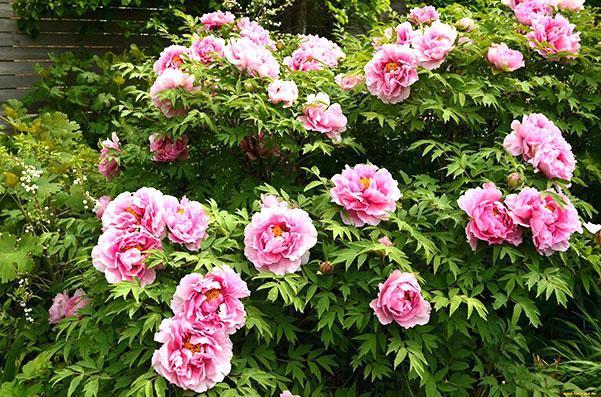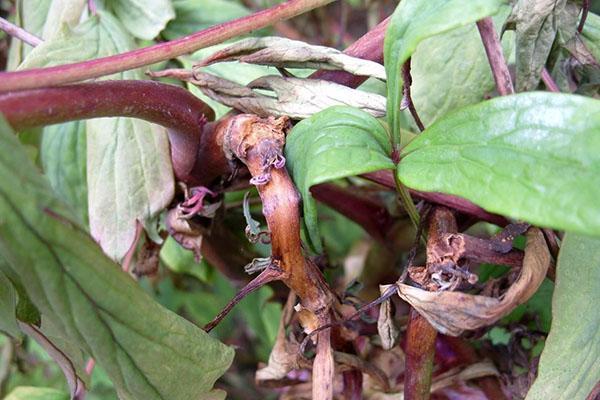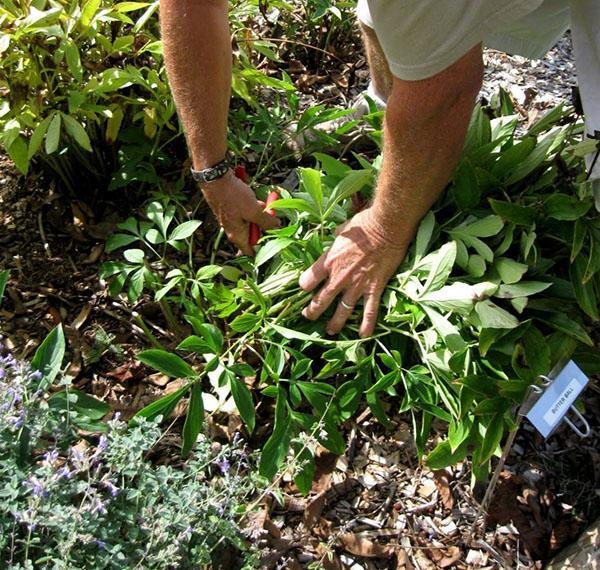Diseases and pests of peonies: looking for ways to protect flowers
 Diseases and pests of peonies, in the overwhelming majority, are the same as in other plants. Compared to other flowers, these decorative crops are considered to be quite resistant to various kinds of lesions. But still, they can be exposed to insects, viruses and fungi. In such cases, it is very important to recognize the disease in time and start treatment correctly.
Diseases and pests of peonies, in the overwhelming majority, are the same as in other plants. Compared to other flowers, these decorative crops are considered to be quite resistant to various kinds of lesions. But still, they can be exposed to insects, viruses and fungi. In such cases, it is very important to recognize the disease in time and start treatment correctly.
Common diseases and pests of peonies
It is necessary to learn to distinguish the diseases of peonies from plant damage by pests.
Gray rot

Gray rot is considered the most dangerous among the diseases and pests of peonies. If a similar disease is observed in peonies, the affected parts of the bush must be cut off, and the plant itself should be sprayed with an aqueous solution of potassium permanganate or copper sulfate. But it is necessary to deal with this problem at its first symptoms. For this, special preparations are used. With a strong defeat, it will be difficult to save the plant.
Mosaic
 It is characterized by greenish, whitish, yellowish spots on the leaves (in the photo, the disease of peonies and the fight against it). They can be of different sizes and shapes. This virus infects tissues at the cellular level. From what the plates are deformed. The spread of the disease leads to a violation of water exchange throughout the plant. As a result, the stems and leaves dry out. First of all, this applies to young processes.
It is characterized by greenish, whitish, yellowish spots on the leaves (in the photo, the disease of peonies and the fight against it). They can be of different sizes and shapes. This virus infects tissues at the cellular level. From what the plates are deformed. The spread of the disease leads to a violation of water exchange throughout the plant. As a result, the stems and leaves dry out. First of all, this applies to young processes.
On other plants, the mosaic spreads in case of any damage to the tools after the diseased bush has been treated (or simply from touching). Wind and insects also play an important role in the transfer of microorganisms from one culture to another.
There are no drugs for mosaics. The only thing that is used to combat this disease is the complete destruction of damaged bushes.
For preventive purposes, when working with plants, disinfect instruments. for this you can use alcohol or regular vodka. You can try to save healthy bushes from infection with an aqueous solution of karbofos. The clothes in which the diseased plant was removed must be heat treated.
Powdery mildew
 Caused by fungi. It mainly affects mature bushes. It usually appears in early summer. Powdery mildew "Likes" hot, humid weather. It is spread by spray during watering, with the help of the wind, on contact with an infected plant. You can recognize it by the white bloom on the leaves and young shoots. First, the leaf plates that are closest to the ground are affected. Over time, this fungus will cover the entire bush.
Caused by fungi. It mainly affects mature bushes. It usually appears in early summer. Powdery mildew "Likes" hot, humid weather. It is spread by spray during watering, with the help of the wind, on contact with an infected plant. You can recognize it by the white bloom on the leaves and young shoots. First, the leaf plates that are closest to the ground are affected. Over time, this fungus will cover the entire bush.
As a result, the appearance of the plant changes. The most affected areas darken and die off. But these are not all problems. Powdery mildew negatively affects the winter hardiness of this decorative culture. A weakened bush can freeze out.Treatment for this disease of peonies is carried out with the help of special preparations purchased in the store, or an aqueous solution of soda, made at home. In the second case, 2 tbsp. l. Calcium bicarbonate is diluted in a bucket of water, the same amount of grated soap is added. Spray well once a week.
Rust
 A characteristic feature of this disease is the presence of brown spores on the back of the leaf plate and yellowish spots on the top of the leaf. If nothing is done, they will soon turn brown and fall off. The danger of this disease is that it is not only able to destroy the green part of the bush, but also lead to the fact that the peonies will not survive the winter.
A characteristic feature of this disease is the presence of brown spores on the back of the leaf plate and yellowish spots on the top of the leaf. If nothing is done, they will soon turn brown and fall off. The danger of this disease is that it is not only able to destroy the green part of the bush, but also lead to the fact that the peonies will not survive the winter.
Rust is spread by wind and water. Penetrating into the plant, the fungus destroys it from the inside.
Can lead to similar problems:
- long cold weather with rains;
- too dense plantations;
- a large amount of nitrogen in the soil.
They fight this disease with the help of fungicides. When the first signs are found, it is recommended to remove and destroy the affected areas. You also need to remove weeds in time and not oversaturate the soil with nitrogen fertilizers.
Often there is such a disease of peonies as leaf rolling. Its treatment can be very simple. This often indicates a lack of potassium in the soil. To eliminate this problem, you will need to feed the plant with fertilizer containing this trace element.
Root rot
 The presence of this disease is indicated by the sudden blackening of the stems. As a rule, gardeners notice this when suddenly in the middle of summer a peony bush or individual stems begin to wither. If you dig up the root of the plant at this time, you can see that it has become brown, soft and has an unpleasant putrid smell.
The presence of this disease is indicated by the sudden blackening of the stems. As a rule, gardeners notice this when suddenly in the middle of summer a peony bush or individual stems begin to wither. If you dig up the root of the plant at this time, you can see that it has become brown, soft and has an unpleasant putrid smell.
Most often, this disease appears due to high humidity, increased acidity of the soil.
Treatment: the roots of the peonies are dug up, cleaned and treated with an aqueous solution of potassium permanganate. In places of cuts, fall asleep with a dry mixture ash and Fundazola. The bush is planted in another place, sprinkling the pit with compost or humus mixed with ash, in non-acidic soil. Other bushes remaining in the same place are treated with fungicidal agents so that the infection does not damage them.
Aphid
 These pests weaken the plant, they can carry the virus, as they are its carrier. To eliminate such insects, the bush is sprinkled with ash or treated with a solution of laundry soap. If they are divorced in very large numbers, peonies are sprayed with chlorophos, iron vitriol or karbofos.
These pests weaken the plant, they can carry the virus, as they are its carrier. To eliminate such insects, the bush is sprinkled with ash or treated with a solution of laundry soap. If they are divorced in very large numbers, peonies are sprayed with chlorophos, iron vitriol or karbofos.
Gall nematode
 Insect larvae penetrate deep into the root, on which galls (balls) of about three millimeters in size appear as a result. Inside these formations are small worms. Penetrating into the ground, they infect other plants.
Insect larvae penetrate deep into the root, on which galls (balls) of about three millimeters in size appear as a result. Inside these formations are small worms. Penetrating into the ground, they infect other plants.
Taking vitality from the bush, they lead to the fact that the leaves are deformed, become too light, the buds are very small, and the flower itself grows slowly or does not develop at all. As a result, the plant may even die.
It is very difficult to destroy these pests of peonies, and the fight against them comes down mainly to removing and burning the bush. The soil should be sprayed with formalin solution.
Ants
 The most undesirable, but, unfortunately, the most common parasites on peony bushes. During the flowering period, these insects feast on nectar. They can bring aphids behind them, so preventing the development of the population ants on bushes, it can also prevent the appearance of aphids.
The most undesirable, but, unfortunately, the most common parasites on peony bushes. During the flowering period, these insects feast on nectar. They can bring aphids behind them, so preventing the development of the population ants on bushes, it can also prevent the appearance of aphids.
Quite often ants settle under bushes. This means that the plant is sick, putrefactive processes occur. These insects do not settle under healthy peonies.
To kill ants, the soil and plants are sprayed with chlorophos or karbofos. Any repellent will also work.
In order to prevent the development of diseases and pests of peonies, it is necessary to take care of prevention.And for this, first of all, it is necessary to treat the soil with greater responsibility. It should be loosened, deacidified, and, if necessary, drained. It is also necessary to properly saturate the earth with trace elements. You need to plant plants at a distance from each other. Since spring you can nourish flowers phosphorus-potassium fertilizers... It is always better to take preventive measures than to treat the plants later. This will save not only money, but also nerves and time.